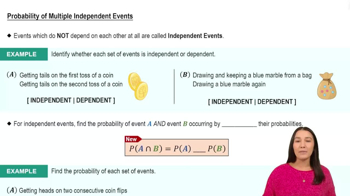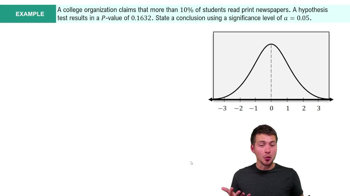Perception and Reality In a presidential election, 308 out of 611 voters surveyed said that they voted for the candidate who won (based on data from ICR Survey Research Group). Use a 0.05 significance level to test the claim that among all voters, the percentage who believe that they voted for the winning candidate is equal to 43%, which is the actual percentage of votes for the winning candidate. What does the result suggest about voter perceptions?
Table of contents
- 1. Intro to Stats and Collecting Data1h 14m
- 2. Describing Data with Tables and Graphs1h 55m
- 3. Describing Data Numerically2h 5m
- 4. Probability2h 16m
- 5. Binomial Distribution & Discrete Random Variables3h 6m
- 6. Normal Distribution and Continuous Random Variables2h 11m
- 7. Sampling Distributions & Confidence Intervals: Mean3h 23m
- Sampling Distribution of the Sample Mean and Central Limit Theorem19m
- Distribution of Sample Mean - Excel23m
- Introduction to Confidence Intervals15m
- Confidence Intervals for Population Mean1h 18m
- Determining the Minimum Sample Size Required12m
- Finding Probabilities and T Critical Values - Excel28m
- Confidence Intervals for Population Means - Excel25m
- 8. Sampling Distributions & Confidence Intervals: Proportion1h 12m
- 9. Hypothesis Testing for One Sample3h 29m
- 10. Hypothesis Testing for Two Samples4h 50m
- Two Proportions1h 13m
- Two Proportions Hypothesis Test - Excel28m
- Two Means - Unknown, Unequal Variance1h 3m
- Two Means - Unknown Variances Hypothesis Test - Excel12m
- Two Means - Unknown, Equal Variance15m
- Two Means - Unknown, Equal Variances Hypothesis Test - Excel9m
- Two Means - Known Variance12m
- Two Means - Sigma Known Hypothesis Test - Excel21m
- Two Means - Matched Pairs (Dependent Samples)42m
- Matched Pairs Hypothesis Test - Excel12m
- 11. Correlation1h 6m
- 12. Regression1h 50m
- 13. Chi-Square Tests & Goodness of Fit1h 57m
- 14. ANOVA1h 57m
9. Hypothesis Testing for One Sample
Steps in Hypothesis Testing
Problem 11.2.8
Textbook Question
Accuracy of Fingerprint Identifications An experiment was conducted to compare the accuracy of fingerprint experts to the accuracy of novices (based on data from “Identifying Fingerprint Expertise,” by Tangen, Thompson, and McCarthy, Psychological Science, Vol. 22, No. 8). The data in the table are based on trials in which the evaluators were given matching fingerprints. Use a 0.05 significance level to determine whether correct identification is independent of whether the evaluator is an expert or a novice.

 Verified step by step guidance
Verified step by step guidance1
Step 1: Define the null hypothesis (H₀) and the alternative hypothesis (H₁). H₀: Correct identification is independent of whether the evaluator is an expert or a novice. H₁: Correct identification is not independent of whether the evaluator is an expert or a novice.
Step 2: Organize the data into a contingency table. The table is already provided: Rows represent evaluator type (Novice and Expert), and columns represent identification outcome (Correct and Wrong).
Step 3: Calculate the expected frequencies for each cell in the contingency table using the formula: E = (row total × column total) / grand total. For example, calculate the expected frequency for 'Novice-Correct' as: E = ((331 + 113) × (331 + 409)) / (331 + 113 + 409 + 35). Repeat for all cells.
Step 4: Compute the chi-square test statistic using the formula: χ² = Σ((O - E)² / E), where O is the observed frequency and E is the expected frequency. Perform this calculation for each cell in the table and sum the results.
Step 5: Compare the calculated χ² value to the critical value from the chi-square distribution table at a significance level of 0.05 with degrees of freedom df = (number of rows - 1) × (number of columns - 1). If χ² > critical value, reject H₀; otherwise, fail to reject H₀.
 Verified video answer for a similar problem:
Verified video answer for a similar problem:This video solution was recommended by our tutors as helpful for the problem above
Video duration:
9mPlay a video:
Was this helpful?
Key Concepts
Here are the essential concepts you must grasp in order to answer the question correctly.
Chi-Square Test of Independence
The Chi-Square Test of Independence is a statistical method used to determine if there is a significant association between two categorical variables. In this context, it helps assess whether the accuracy of fingerprint identification (correct or wrong) is independent of the evaluator's expertise (novice or expert). The test compares observed frequencies in each category to expected frequencies under the assumption of independence.
Recommended video:

Probability of Multiple Independent Events
Significance Level (α)
The significance level, denoted as α, is the threshold for determining whether a statistical result is significant. In this case, a significance level of 0.05 indicates that there is a 5% risk of concluding that a difference exists when there is none. If the p-value obtained from the Chi-Square test is less than 0.05, we reject the null hypothesis, suggesting that the accuracy of identification is not independent of the evaluator's expertise.
Recommended video:
Guided course

Step 4: State Conclusion Example 4
Contingency Table
A contingency table is a matrix that displays the frequency distribution of variables, allowing for the analysis of the relationship between them. In this scenario, the table shows the number of correct and wrong identifications made by novices and experts. This format is essential for conducting the Chi-Square Test, as it organizes the data needed to evaluate the independence of the two categorical variables.
Recommended video:
Guided course

Finding Standard Normal Probabilities using z-Table

 6:21m
6:21mWatch next
Master Step 1: Write Hypotheses with a bite sized video explanation from Patrick
Start learningRelated Videos
Related Practice
Textbook Question
